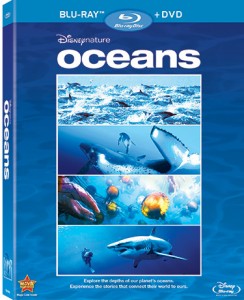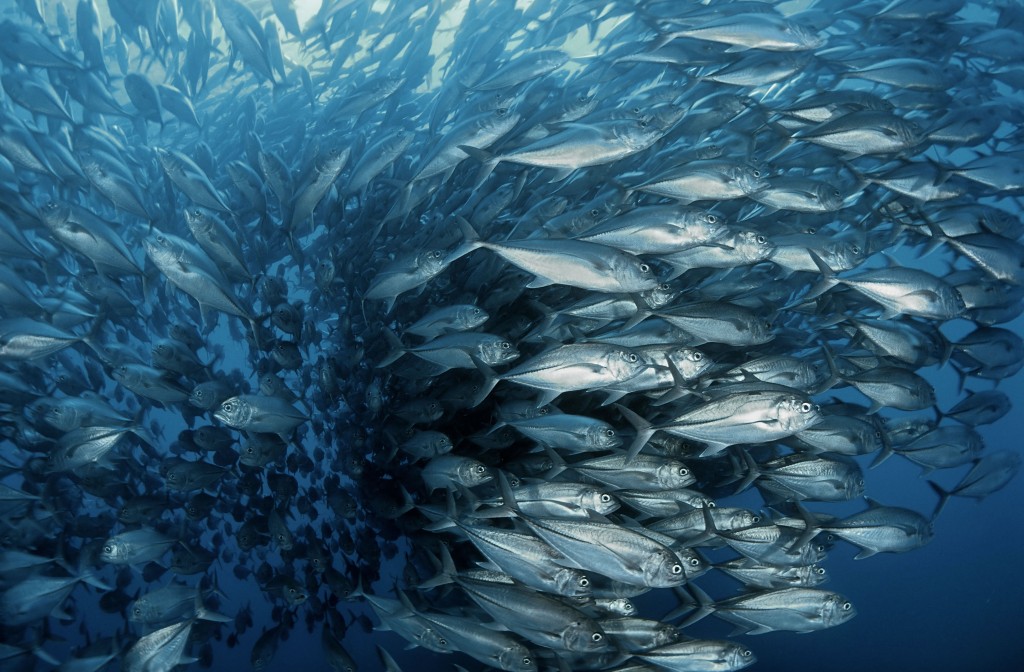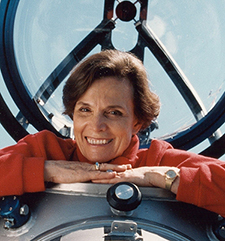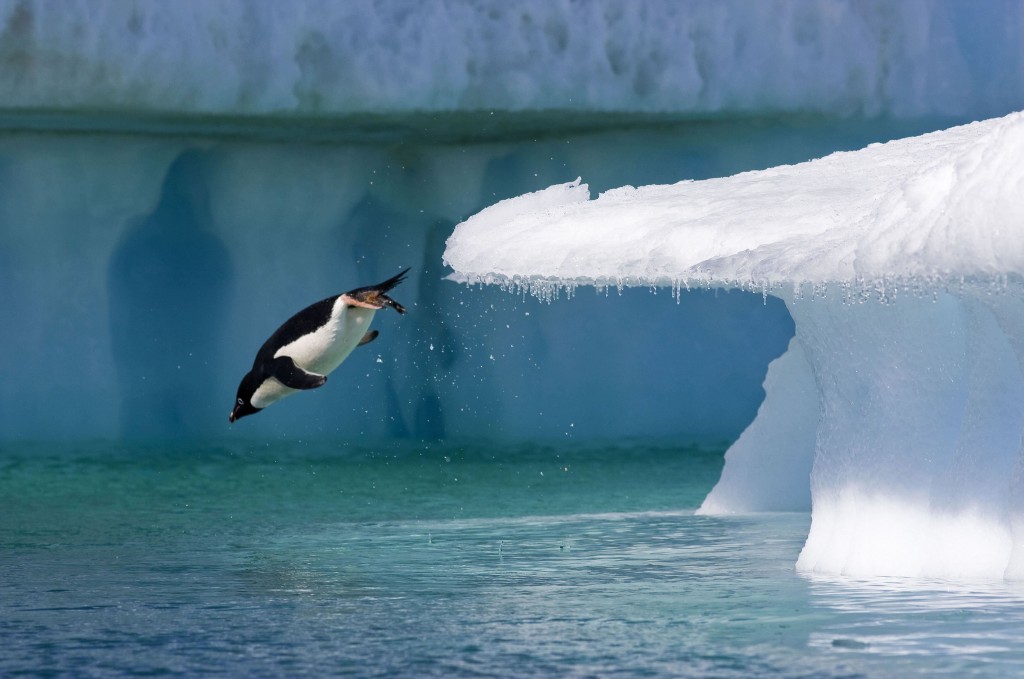
Earlier this year, Disneynature Oceans premiered in theaters across the country, perfectly timed with Earth Day. This is the second production by Disneynature and offers an extraordinary look at “the mysteries that lie beneath.” Here is a brief synopsis of the film, from the site:
Nearly three-quarters of the Earth’s surface is covered by water and OCEANS boldly chronicles the mysteries that lie beneath. Directors Jacques Perrin and Jacques Cluzaud dive deep into the very waters that sustain all of mankind—exploring the harsh reality and the amazing creatures that live within. Narrated by Pierce Brosnan and featuring spectacular never-before-seen imagery captured by the latest underwater technologies, OCEANS offers an unprecedented look beneath the sea in a powerful motion picture.
This is my first time viewing a Disneynature film and all I can describe it in one word…breathtaking. I’m in awe of how the filmmakers managed to capture a flock of birds diving to feed on a group of sardines… and a group of dolphins gliding across the ocean…and a great white shark! The cinematography was outstanding. The colors of the ocean and the sky are surreal…the music captures the emotion of ocean life. The movie offered the appropriate blend of narration, music, and sounds from the sea and it’s inhabitants. You have to see a movie like this to truly appreciate the vastness that is our ocean. The only thing that would have enhanced this experience would be to see it in the theater (IMAX perhaps?)


Disneynature Oceans is educational, engaging, and a must-see for adults and children alike.

Last week, several bloggers gathered for a virtual round-table discussion with Dr. Sylvia Earle, world renowned oceanographer, explorer, scientist, author, lecturer, and advisor for Disneynature (specifically Oceans). Here are some of my favorite highlights from our discussion:
Q – Dr. Earle, what was the most awe-inspiring sight you have seen in your explorations of the ocean?
A – Dr. Sylvia Earle: Many things qualify as the “most” — being face to face with humpback whales, being in a one person submersible 3,000 feet down, dancing with an octopus near Lahaina, Hawaii. But all things considered, most impressive are the changes that have taken place in my lifetime — more than during all preceding human history.
Q – Being down in the deep ocean, what is it like swimming side by side the big sharks and whales? Do they even acknowledge your swimming next to them or do you distract them in some way?
A – Dr. Sylvia Earle: It is exhilarating being with large animals in the ocean, especially when they look into my eyes, apparently curious about my presence. There is no place to hide in the open sea!
Q – What types of changes have taken place in the last hundred years?
A – Dr. Sylvia Earle: Profound changes have taken place globally since the start of the 20th century – to the air, the world’s waters, and life everywhere, land and sea. For the past ten years more than 2700 scientists have been assessing the state of life in the oceans, past, present and future, during the “Census of Marine life.” While thousands of new species were discovered, the sharp decline of many creatures was cause for great concern. Industrial fishing has had an enormous impact, pushing some species to 10 per cent of their numbers from 50 or 60 years ago. On the positive side, protection for the ocean is beginning to increase as well. About 1% of the ocean is now protected within a park or sanctuary of some sort, and many nations, including the United States, recognize the need to take a new look at policies that will help restore health to the ocean.
Q – Dr. Earle, what do believe is the greatest threat to the world’s oceans currently?
A – Dr. Sylvia Earle: Obvious threats include what we are putting into the sea (millions of tons of pollutants) and what we are taking out (millions of tons of ocean wildlife), as well as profound disturbance to natural shoreline systems — mangroves, marshes, sea grass meadows, kelp forests, coral reefs and even healthy, natural sandy beaches. But far and away the biggest problem is ignorance, something that OCEANS helps to solve. When people understand how important the ocean is to their lives, and how much damage we are causing, they can respond with action. If people don’t know, they can’t care.
Q – I would imagine every trip down below is a completely new adventure. But if there was one singular instance that stands out above the rest while filming OCEANS, what would you consider
it to be?
A – Dr. Sylvia Earle: The film team had unparalleled experiences while filming OCEANS from pole to pole. Using new techniques, they were able to keep pace with dolphins as if they were a part of the pod themselves, but probably their infinite patience is what made possible some of the best moments — such as the scenes of blue whales feeding. Many weeks were invested just waiting for the right moment.
Q – Why do you think films like this are important to be made? Do they serve a purpose beyond entertainment and shock and awe?
A – Dr. Sylvia Earle: OCEANS inspires people to think differently about the ocean. With knowing, comes caring, and with caring there is hope that we will respect the ocean — and find an enduring place for ourselves within the systems that keep us alive.
Q – Is there anything that a normal everyday family can do to help preserve the oceans?
A – Dr. Sylvia Earle: Yes! Learn everything you can about the ocean and what it does as Earth’s “life support system” — generating oxygen, taking up carbon dioxide, providing home for most of life on Earth — and most of the water (97%), too. Support plans and organizations that are taking care of the ocean . . .make good choices about what to eat (tuna, swordfish, sharks and many others are in trouble and should be avoided – — low on the food chain fish such as tilapia and catfish are better, all vegetables best of all). Whatever your interests or talents are, use them to let others understand that the ocean is in trouble and needs our help. Support protected areas in the ocean — like national parks for the sea. Never go to a beach without leaving it in better (cleaner) condition than you found it. Most of all, go dive in and listen to the ocean . . .
Q – Do you have a favorite spot that you would like to return too in the sea?
A – Dr. Sylvia Earle: I would love to return to the ocean as it was 50 years ago! Actually, there are places that remain in good condition, as was demonstrated beautifully in OCEANS. Much of the ocean has been damaged by human actions, but there is still time to protect even one of my favorite places — the Gulf of Mexico — and restore damaged systems. I love going back to places repeatedly over time, but it is always exciting to explore new areas. Since only 5% of the ocean has been seen by anyone (let alone really explored) there is a lot left to do!
Q – If there was one place on the planet, yet unexplored in our Oceans, where would you like to explore if you could?
A – Dr. Sylvia Earle: I want to explore all of it, of course. . .95% has not been seen by anyone. If I could, I would love to be able to go to the deepest place, the Mariana Trench, 7 miles down, a place seen once in 1960 by two men for about half an hour. If a submarine could be developed to return there, it would be possible to go anywhere in the ocean. It is frustrating that it is difficult even to go as deep as 5,000 feet to see the site of the Deepwater Horizon blowout. There are many thousands of aircraft and ships, but in the whole world only about 5 submarines that can take people as much as half the ocean’s depth. I want to go all the way!
Q – With your vast diving experience, is there any specific species that you have yet to encounter but would especially like to have the opportunity to see in its natural habitat?
A – Dr. Sylvia Earle: I would love to see the ultimate “calamari” — the giant squid — in its natural surroundings, thousands of feet under the sea. But I also am eager to see narwhals . . . to cruise around hydrothermal vents under the Arctic ice . . .to visit sea mounts in the open ocean . . .to explore, explore and explore.
Q – Dr. Earle in your opinion, how has global warming affected the ocean?
A – Dr. Sylvia Earle: Global warming without a doubt is affecting life in the sea. This year a widespread “coral bleaching” event is occurring, driven in large measure by sustained higher-than-normal temperatures. The first such event was observed in 1980, correlated with a time of unusual warming, and has happened repeatedly in the years since. Some fish appear to be moving northward into areas previously too cold for their liking, coincident with increasing warm temperatures. Temperature has a profound effect on all forms of life. The current warming trend is thought to be implicated in the 40% drop in plankton noted since 1950.
Q – How deep is the farthest on record that anyone has gone down in the ocean?
A – Dr. Sylvia Earle: The deepest dive took place in 1960 when Don Walsh and Jacques Piccard went in the bathyscaphe Trieste to 35,800 feet, the bottom of the Mariana Trench. No one has been back since! Japan developed a remotely operated vehicle that made several dives in the trench but was lost at sea in a storm. The Woods Hole Oceanographic Institution last year launched a new robotic system that has made several dives there and recorded many new images and gathered samples of marine life from that stupendous depth. But no humans have been back — yet. Some of us really want to go, and I hope many will be able to do so within a few years. It is, after all, only 7 miles! Planes take people that high in the sky with movies (even OCEANS), pillows, and lunch.
Disneynature Oceans is now available on Blu-Ray and DVD.

No compensation was received for this post. A copy of the DVD was provided to facilitate this review.
- Discover Luxury at Sonesta Irvine: Your Ideal Staycation - August 8, 2024
- CHOC Walk Returns to the Disneyland Resort – Special Events and Ways to Support - June 28, 2023
- Beastly Ball Returns to the Los Angeles Zoo - May 8, 2023

Leave a Reply